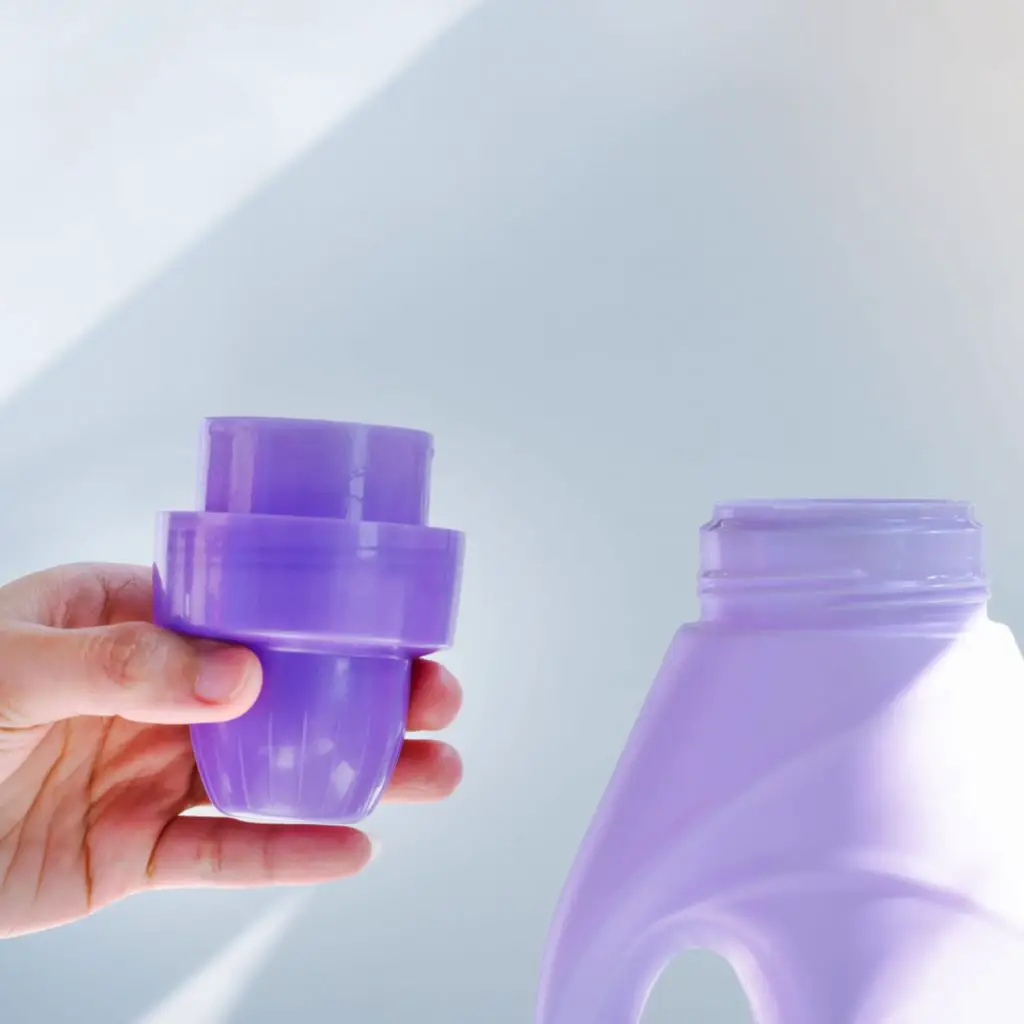When it comes to caring for delicate fabrics, using fabric softener can be a double-edged sword if you don't approach it correctly. You'll want to choose a gentle, hypoallergenic option and dilute it properly to avoid damage. Before you even think about washing, there are crucial pre-wash steps you should take to ensure your delicate items stay in pristine condition. Understanding these nuances can make all the difference, especially when it comes to drying and storing your fabrics. So, what's the best way to get started?
Table of Contents
Key Takeaways
- Choose gentle, hypoallergenic fabric softeners labeled safe for delicate fabrics to protect fibers during washing.
- Dilute fabric softener with water at a 1-to-3 ratio, or 1-to-4 for very delicate items, to prevent residue buildup.
- Always use cold water and a gentle cycle; hand washing is recommended for maximum care of delicate fabrics.
- Air dry delicate items away from direct sunlight, laying them flat or hanging them on padded hangers to maintain shape.
Understanding Delicate Fabrics
Delicate fabrics, like silk and lace, require special attention to maintain their beauty and integrity. You'll often find these materials in your favorite garments or home textiles, but they can be tricky to care for. Understanding their unique characteristics is essential for preserving their quality.
Silk, for instance, is known for its luxurious feel and sheen but can lose its luster if not handled properly. It's sensitive to moisture and can be damaged by harsh detergents or improper washing techniques.
Lace, on the other hand, is intricate and can easily snag or tear if you're not careful.
When you wash delicate fabrics, always opt for cold water and gentle cycles. Hand washing is often recommended, as it minimizes agitation and reduces the risk of damage.
It's also crucial to avoid wringing or twisting these fabrics, as this can distort their shape. Instead, gently press out excess water by laying them flat on a clean towel.
Choosing the Right Fabric Softener
When selecting a fabric softener for your delicate fabrics, it's important to choose one that's specifically formulated to protect their unique fibers. Not all fabric softeners are created equal, and using the wrong one can lead to damage or reduced lifespan of your cherished garments.
Here are some key factors to consider:
- Formulation: Look for softeners labeled as “gentle” or “safe for delicates.” These products often have milder ingredients that won't harm delicate fabrics like silk or lace.
- Scent: If you're sensitive to fragrances, opt for unscented or hypoallergenic options. These can still provide the softness you want without overwhelming scents.
- Concentration: Choose a concentrated formula, as you'll need less product to achieve the desired softness. This not only saves you money but also reduces the risk of residue build-up on your fabrics.
- Compatibility: Ensure the fabric softener is compatible with your washing machine type, whether it's front-loading or top-loading, to maximize effectiveness and safety.
Pre-Wash Considerations
Before washing your delicate fabrics, take a moment to check for any specific care instructions on the label to ensure they're handled properly. These labels provide vital information about washing temperatures, drying methods, and whether fabric softeners are safe to use. Following these guidelines can help preserve the integrity and appearance of your items.
Next, inspect your fabrics for any stains or spots. Treat these areas with a suitable stain remover before washing. If you notice any loose threads or damage, repair them to prevent further issues during the wash.
Additionally, consider sorting your delicate fabrics by color and fabric type. Washing similar items together reduces the risk of color bleeding and fabric damage. It's also a good idea to place delicate items in a mesh laundry bag, which can offer extra protection during the wash cycle.
Lastly, remember to choose a gentle cycle on your washing machine. This minimizes agitation and helps maintain the quality of your fabrics. By taking these pre-wash considerations into account, you're setting yourself up for success in caring for your delicate pieces.
Diluting Fabric Softener
When you use fabric softener on delicate fabrics, dilution is key to preventing damage.
You'll want to follow recommended ratios to ensure it's effective yet gentle.
Let's explore the best application techniques to keep your delicate items looking their best.
Importance of Dilution
Diluting fabric softener is crucial to prevent damage to delicate fabrics while still achieving a soft, pleasant feel.
Using undiluted softener can lead to residue build-up, which may cause fabrics to become stiff or even lose their luster.
By properly diluting your fabric softener, you'll ensure it effectively softens your laundry without compromising the integrity of those delicate materials.
Here are some important reasons to dilute fabric softener:
- Prevents Staining: Undiluted fabric softener can leave spots on fabrics, ruining their appearance.
- Enhances Absorbency: Dilution helps maintain the absorbent qualities of towels and other fabrics, ensuring they remain functional.
- Extends Fabric Lifespan: Proper dilution minimizes wear and tear, allowing your delicate items to last longer.
- Improves Performance: Diluted softener distributes more evenly in the wash, maximizing its effectiveness without overwhelming the fabric.
Recommended Ratios
Finding the right dilution ratio for fabric softener is essential to keep your delicate fabrics looking their best. Generally, a good starting point is mixing one part fabric softener with three parts water. This ratio ensures that your fabrics receive the benefits of softening without overwhelming them with concentrated chemicals.
If you're dealing with particularly delicate materials like silk or lace, consider diluting the fabric softener even more—try a one-to-four or even one-to-five ratio. This extra caution helps prevent any potential damage while still providing that soft finish you want.
Always check the fabric softener's label for specific recommendations, as different brands might have varying concentrations and formulas. If you're unsure, it's better to err on the side of caution and use less fabric softener. You can always adjust the ratio in future washes based on how your fabrics respond.
After mixing, store the diluted solution in a labeled spray bottle for easy access. This way, you'll always have the right amount on hand when you do laundry.
With the right dilution, your delicate fabrics will stay soft, vibrant, and well-cared for.
Application Techniques
To effectively apply diluted fabric softener, you'll want to spray it evenly onto your delicate fabrics before washing. This technique helps ensure that the softener penetrates the fibers without causing damage.
Here's how to do it:
- Prepare the Solution: Mix the recommended amount of fabric softener with water in a spray bottle. A common ratio is 1 part fabric softener to 3 parts water.
- Test a Small Area: Before applying it to the entire fabric, spray a small, inconspicuous area to check for any adverse reactions.
- Spray Evenly: Hold the spray bottle about 6-8 inches away from the fabric. Lightly mist the fabric, making sure to cover all surfaces evenly without soaking it.
- Let It Sit: Allow the diluted fabric softener to sit for about 10-15 minutes. This gives it time to work into the fibers before washing.
Proper Washing Techniques
When washing delicate fabrics, always opt for a gentle detergent specifically designed for sensitive materials. This will help maintain the integrity of the fibers while effectively removing dirt and stains. Before you start, check the care label for specific instructions, as each fabric may have unique requirements.
When you're ready to wash, use a mesh laundry bag to protect your delicate items further. This prevents snagging and tangling with other garments. If possible, wash your delicate fabrics on a cold, gentle cycle to minimize stress on the fibers. Avoid using the regular cycle, as it can be too harsh.
Never overload your washing machine; this can cause friction and damage your delicate fabrics. Instead, wash smaller batches to ensure even cleaning. If you've got heavily soiled items, treat spots with a bit of detergent before washing, but don't rub too hard.
Lastly, consider hand-washing for the most delicate items. Fill a basin with cold water and add your gentle detergent. Swirl gently, soak for a few minutes, then rinse thoroughly. This method ensures your delicate fabrics receive the utmost care during washing.
Drying Delicate Fabrics
When it comes to drying delicate fabrics, you've got a couple of great options to consider.
Air drying is one of the safest methods, while using low heat settings in the dryer can also do the trick without risking damage.
Let's explore these techniques to keep your delicate items looking their best.
Air Drying Techniques
Air drying delicate fabrics is essential for preserving their quality and preventing damage from heat. When you choose to air dry, you're not just protecting the fabric; you're also helping maintain its shape and color.
Here are some effective air drying techniques to keep in mind:
- Gently wring out excess water: After washing, carefully squeeze out the water without twisting the fabric too much. This prevents stretching and damage.
- Lay flat on a clean surface: For items like sweaters, lay them flat on a drying rack or clean towel. This helps maintain their shape and prevents stretching.
- Hang with care: For lightweight fabrics, hang them on a padded hanger or a clothesline. Ensure they're spaced out to allow air circulation, which speeds up drying.
- Avoid direct sunlight: Keep your delicate fabrics out of direct sunlight to prevent fading and deterioration. Opt for a shaded area instead.
Low Heat Settings
Using low heat settings on your dryer can effectively safeguard delicate fabrics from damage while still ensuring they dry properly. High temperatures can weaken fibers, causing shrinkage or even fabric breakdown. By opting for low heat, you minimize this risk and maintain the integrity of your garments.
Before you toss your delicate items into the dryer, make sure you check the care labels. Some fabrics, like silk or lace, may be better off air-dried, but for those that can handle some machine drying, low heat is your best bet. It's also smart to separate delicate fabrics from heavier items, as the latter can create friction and lead to potential snags.
Consider using dryer balls or clean tennis balls, too. They help circulate air within the dryer, allowing your delicate items to dry more evenly. Keep an eye on the drying cycle, as delicate fabrics can dry faster than you expect.
Once done, promptly remove your clothes to prevent any lingering wrinkles. With these tips in mind, you'll keep your delicate fabrics looking beautiful and prolong their lifespan.
Storing Delicate Items
Storing delicate items properly can help prevent damage and extend their lifespan. When you take the time to store your fabrics right, you'll avoid unnecessary wear and tear. Here are some key tips to keep in mind:
- Clean Before Storing: Always wash and dry your delicate items before putting them away. This removes any dirt or oils that could cause stains over time.
- Use Acid-Free Tissue: For items like silk or lace, place acid-free tissue paper between layers. This helps maintain their shape and prevents creasing.
- Choose the Right Container: Store your delicate fabrics in breathable cotton bags or acid-free boxes. Avoid plastic, as it can trap moisture and lead to mildew.
- Keep in a Cool, Dry Place: Find a storage area that's cool and dry. Avoid attics or basements where temperature and humidity fluctuate, as these conditions can harm your fabrics.
Frequently Asked Questions
Can I Use Fabric Softener on Wool and Silk?
You shouldn't use fabric softener on wool or silk. It can damage their fibers, leading to loss of shape and texture. Instead, opt for gentle detergents specifically designed for these delicate fabrics to maintain their quality.
What Should I Do if Fabric Softener Causes Stains?
If fabric softener causes stains, immediately rinse the affected area with cold water. Gently blot the stain with a mild detergent solution, then rinse again. Always test cleaners on a hidden fabric section first.
How Often Should I Use Fabric Softener on Delicate Items?
You should use fabric softener on delicate items sparingly, ideally once every few washes. Overusing it can lead to buildup, affecting the fabric's texture and appearance. Always read care labels for specific recommendations.
Are There Eco-Friendly Fabric Softeners for Delicate Fabrics?
Yes, there are eco-friendly fabric softeners specifically designed for delicate fabrics. Look for brands that use natural ingredients, avoid harsh chemicals, and are biodegradable. These options help you care for your clothes and the environment.
Can Fabric Softener Affect the Color of Delicate Fabrics?
Yes, fabric softener can affect the color of delicate fabrics. It may cause fading or discoloration over time, especially if the fabric is prone to such changes. Always test a small area first to be safe.
- How to Care for Delicate Fabrics to Prevent Shrinking? - June 9, 2025
- Can You Unshrink a Blended Fabric Garment? - June 9, 2025
- Stop Your Sweaters From Shrinking: Best Washing Practices - June 9, 2025







